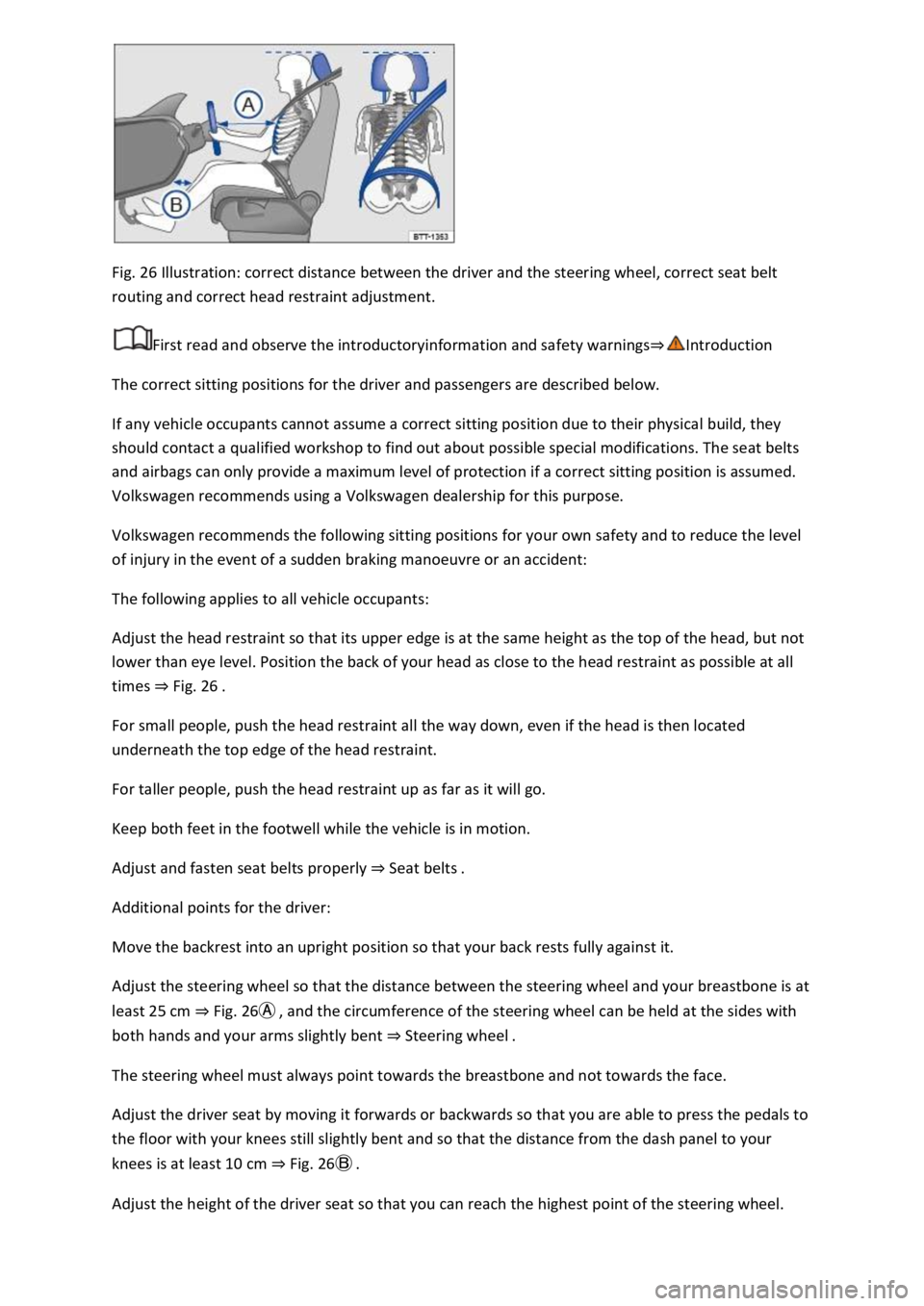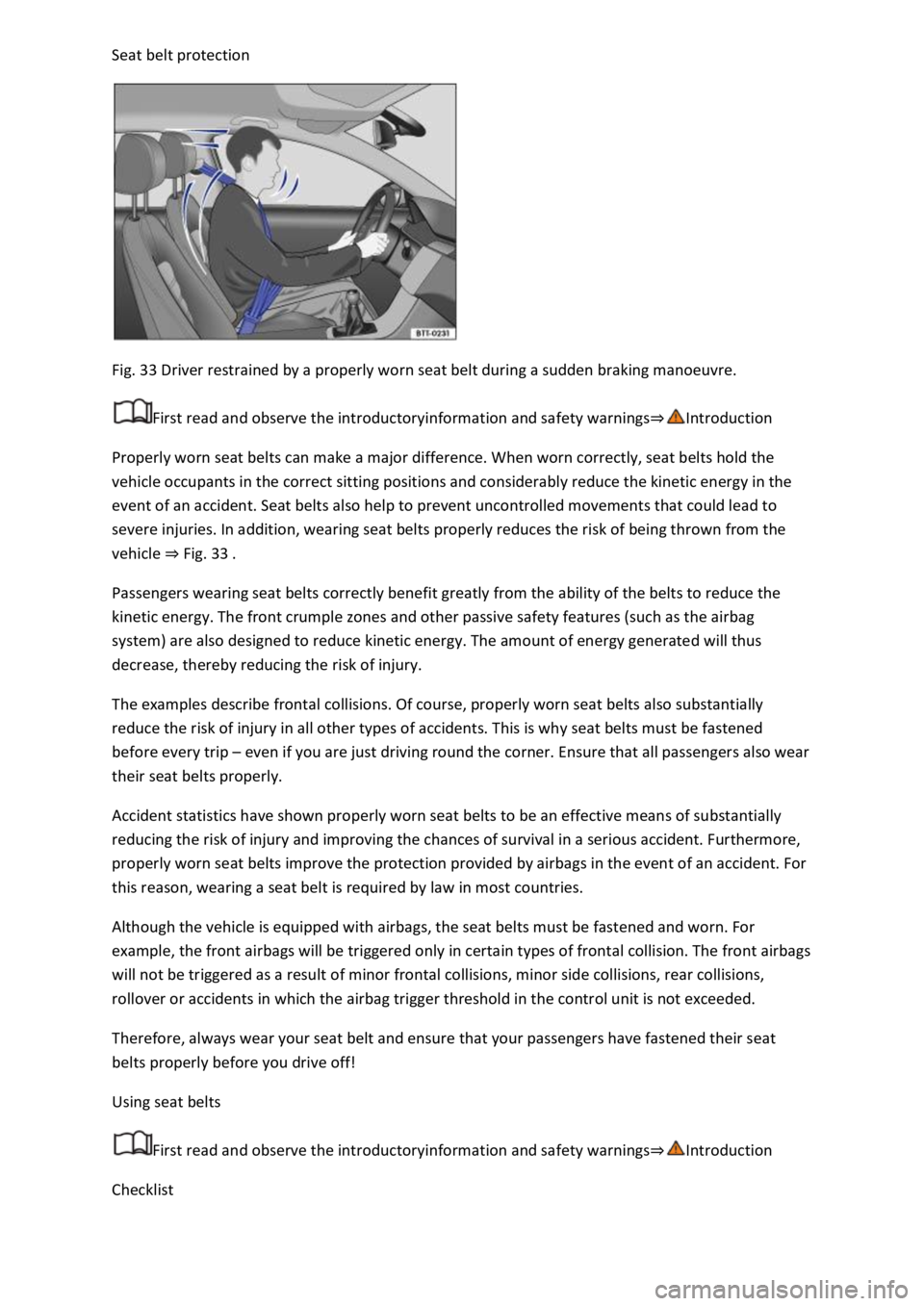airbag VOLKSWAGEN T-ROC 2019 Owners Manual
[x] Cancel search | Manufacturer: VOLKSWAGEN, Model Year: 2019, Model line: T-ROC, Model: VOLKSWAGEN T-ROC 2019Pages: 502, PDF Size: 8.58 MB
Page 6 of 502

In the engine compartment
Fuse box cover Changing fuses
Lever for adjusting the steering column position Steering wheel
Light switch Vehicle lighting
Turn signal and main beam lever Vehicle lighting
With switches and buttons for the driver assist systems Button for driver assist systemsDriver
assist systems
Vents Heating and air conditioning system
Instrument cluster Instrument cluster
With warning and indicator lamps Symbols in instrument cluster
Lever for wipers and washers Wipers
With buttons for operating the menus Instrument cluster
Controls on the multifunction steering wheel:
Operating driver assist systems Operating using the multifunction steering wheelDriver assist
systems
Audio, navigation
Opening the telephone menu or accepting telephone calls
Volume adjustment
Activating voice control (no function in some models)
Horn
Location of the driver front airbag Airbag system
Ignition lock Starting and stopping the engine
Pedals Pedals
Page 8 of 502

In an emergency
Indicator lamp for the front passenger front airbag switch-off function Airbag system
Driver assist systems Driver assist systems
Controls for the air conditioning system, heating and fresh air system Heating, ventilating,
cooling
Controls for the air conditioning system, heating and fresh air system Heating, ventilating,
cooling
Key to Fig. 9
Lever:
DSG
Page 9 of 502

Front passenger side
Fig. 10 Overview of the front passenger side (left-hand drive vehicles). The location is mirrored in
right-hand drive vehicles.
Key to Fig. 10
Vents Heating and air conditioning system
At the side of the dash panel: key-operated switch for disabling the front passenger front airbag
Airbag system
Operating lever for the stowage compartment Stowage areas
Controls in the roof
Symbol Meaning
Buttons for interior and reading lights Interior lighting.
Switch for glass roof Glass roof.
Buttons for the sun blind Protection from the sun.
Buttons for emergency call service, information call and breakdown call In an
emergency
Driver information
Symbols in instrument cluster
The warning and indicator lamps indicate various warnings, faults or certain functions. Some
warning and indicator lamps light up when the ignition is switched on and must go out once the
engine is running or the vehicle is in motion.
Depending on the vehicle equipment level, symbols may be displayed in the instrument cluster
instead of warning lamps.
Page 50 of 502

Turn signals
Side lights, dipped beam headlights and main beam headlights
Tail light clusters
Brake lights
Rear fog light
Number plate light
Information on changing bulbs Changing bulbs
DANGER
Please observe important safety information about the front passenger front airbag Fitting and
using chi
WARNING
Driving under the influence of alcohol, drugs, medication or narcotics could cause accidents and fatal
injuries.
Alcohol, drugs, medication and narcotics can severely impair senses, reaction times and driving
safety. This could cause you to lose control of the vehicle.
WARNING
Always observe current traffic regulations and speed limits, and think ahead when driving. The
correct interpretation of the driving situation can make the difference between reaching your
destination safely and having an accident with serious injuries.
NOTICE
Volkswagen is not responsible for any vehicle damage caused by low-quality fuel, inadequate
servicing work or non-availability of Genuine Parts.
Observe the instructions and information for vehicles with an N1 approval Information about
vehicles with N1 approval (light commercial vehicle)
Page 51 of 502

not only about vehicle maintenance it also ensures that your vehicle
remains roadworthy and in perfect working order. You should therefore have your vehicle serviced
according to the Volkswagen guidelines. Some work may have to be carried out before the date of
the next service if the vehicle is subjected to severe operating conditions. Severe operating
conditions are, for example, regular stop-and-go driving or driving in areas with high levels of dust.
Further information can be obtained from your Volkswagen dealership or qualified workshop.
Sitting position
Introduction
This chapter contains information on the followingsubjects:
Dangers of assuming an incorrect sitting position
Correct sitting posi
Number of seats
The vehicle has a total of five seats: two at the front and three at the rear.
Each seat is equipped with a seat belt.
WARNING
Assuming an incorrect sitting position in the vehicle can increase the risk of severe or fatal injuries
during a sudden driving or braking manoeuvre in the event of a collision or accident or if the airbags
are triggered.
All vehicle occupants must assume a correct sitting position before setting off and maintain this
position throughout the trip. This also applies for the fastening of seat belts.
The number of vehicle occupants must never exceed the number of seats with seat belts in the
vehicle.
Always secure children in the vehicle in an authorised child restraint system which is suitable for
their height and weight Safe transport of childrenand Airbag system
Always keep your feet in the footwell while the vehicle is in motion. Never place your feet on the
seat or dash panel, for example, and never ride with your feet out of the window. The airbag and
seat belt can otherwise not provide optimal protection and can actually increase the risk of injury
during an accident.
Dangers of assuming an incorrect sitting position
First read and observe the introductoryinformation and safety warnings
If the seat belts are not worn or are worn incorrectly, the risk of severe or fatal injuries increases.
Seat belts can provide optimal protection only if seat belt routing is correct. An incorrect sitting
position considerably impairs the level of protection provided by a seat belt. This could lead to
severe or even fatal injuries. The risk of severe or fatal injuries is especially increased when a
Page 52 of 502

is responsible for all occupants transported in the vehicle, especially children.
The following list contains examples of sitting positions that can be dangerous for all vehicle
occupants.
Whenever the vehicle is in motion:
Never stand in the vehicle.
Never stand on the seats.
Never kneel on the seats.
Never tilt the backrest too far to the rear.
Never lean against the dash panel.
Never lie on the seats in the passenger compartment and on the rear bench seat.
Never sit on the front edge of a seat.
Never sit sideways.
Never lean out of a window.
Never put your feet out of a window.
Never put your feet on the dash panel.
Never place your feet on the seat cushion or seat backrest.
Never travel in a footwell.
Never sit on the armrests.
Never travel on a seat without wearing the seat belt.
Never travel in the luggage compartment.
WARNING
Every incorrect sitting position in the vehicle increases the risk of severe or fatal injuries in the event
of an accident or sudden driving or braking manoeuvre.
All vehicle occupants must maintain a correct sitting position and wear their seat belt properly while
the vehicle is in motion.
Sitting in an incorrect position, not fastening the seat belt, or not leaving adequate space between
the occupants and the airbags could inflict critical or fatal injuries, especially if the airbags deploy
and strike an occupant who has assumed an incorrect sitting position.
Correct sitting position
Page 53 of 502

Fig. 26 Illustration: correct distance between the driver and the steering wheel, correct seat belt
routing and correct head restraint adjustment.
First read and observe the introductoryinformation and safety warnings
The correct sitting positions for the driver and passengers are described below.
If any vehicle occupants cannot assume a correct sitting position due to their physical build, they
should contact a qualified workshop to find out about possible special modifications. The seat belts
and airbags can only provide a maximum level of protection if a correct sitting position is assumed.
Volkswagen recommends using a Volkswagen dealership for this purpose.
Volkswagen recommends the following sitting positions for your own safety and to reduce the level
of injury in the event of a sudden braking manoeuvre or an accident:
The following applies to all vehicle occupants:
Adjust the head restraint so that its upper edge is at the same height as the top of the head, but not
lower than eye level. Position the back of your head as close to the head restraint as possible at all
times Fig. 26
For small people, push the head restraint all the way down, even if the head is then located
underneath the top edge of the head restraint.
For taller people, push the head restraint up as far as it will go.
Keep both feet in the footwell while the vehicle is in motion.
Adjust and fasten seat belts properly Seat belts
Additional points for the driver:
Move the backrest into an upright position so that your back rests fully against it.
Adjust the steering wheel so that the distance between the steering wheel and your breastbone is at
least 25 cm Fig. 26
both hands and your arms slightly bent Steering wheel
The steering wheel must always point towards the breastbone and not towards the face.
Adjust the driver seat by moving it forwards or backwards so that you are able to press the pedals to
the floor with your knees still slightly bent and so that the distance from the dash panel to your
knees is at least 10 cm Fig. 26
Adjust the height of the driver seat so that you can reach the highest point of the steering wheel.
Page 54 of 502

Additional points for the front passenger:
Move the backrest into an upright position so that your back rests fully against it.
Push the front passenger seat as far back as possible so that the airbag can provide maximum
protection if it is deployed.
Seat belts
Introduction
This chapter contains information on the followingsubjects:
Warning lamp
Frontal collisions and the laws of physics
What happens to vehicle occupants who have not fastened their seat belts
Seat belt protection
Using seat belts
Fastening and unfastening seat belts
Seat belt routing
Seat belt height adjuster
Belt retractor, belt tensioner, belt tension limiter
Service and disposal of belt tensioners
Proactive occupant protection system
Regularly check the condition of all seat belts. If the belt webbing, belt connections, belt retractor or
seat belt buckle become damaged, the seat belt in question should be replaced immediately by a
qualified workshop
compatible with the vehicle, equipment level and model year. Volkswagen recommends using a
Volkswagen dealership for this purpose.
WARNING
Incorrectly fastened or unfastened seat belts increase the risk of severe or fatal injuries. Seat belts
will only offer the optimum level of protection when they are fastened and used properly.
Seat belts are the most effective means of reducing the risk of serious and fatal injuries in the event
of an accident. Seat belts must always be fastened properly when the vehicle is in motion to protect
the driver and all vehicle occupants.
Page 58 of 502

Fig. 31 An unbelted driver is thrown forward.
Fig. 32 The unbelted rear passenger is thrown forward and strikes the belted driver.
First read and observe the introductoryinformation and safety warnings
Many people believe that the occupants can brace their weight with their hands in a minor collision.
This is not true.
Even at low speeds, the forces acting on the body in a collision are so great that it is not possible to
brace yourself with your arms and hands. In a frontal collision, vehicle occupants who have not
fastened their seat belts will be thrown forward and will make unchecked contact with parts of the
vehicle interior, e.g. the steering wheel, dash panel, or windscreen Fig. 31
The airbag system is not a substitute for the seat belts. Airbags provide only additional protection
when deployed. Airbags will not be triggered in all kinds of accidents. Even if the vehicle is equipped
with an airbag system, all vehicle occupants, including the driver, must fasten their seat belt and
wear it correctly while the vehicle is in motion. This will reduce the risk of severe or fatal injuries in
the event of an accident regardless of whether an airbag is fitted for the seat.
An airbag can be triggered only once. To achieve the best possible protection, the seat belt must
always be worn properly so that you will be protected in accidents in which no airbag is deployed.
Any vehicle occupants not wearing a seat belt can be thrown out of the vehicle and sustain more
severe or even fatal injuries as a result.
It is also important for the rear seat occupants to wear seat belts properly, as they could otherwise
be thrown forwards violently in an accident. Rear seat passengers who are not wearing seat belts
endanger not only themselves and the driver, but also other people in the vehicle Fig. 32
Page 59 of 502

Fig. 33 Driver restrained by a properly worn seat belt during a sudden braking manoeuvre.
First read and observe the introductoryinformation and safety warnings
Properly worn seat belts can make a major difference. When worn correctly, seat belts hold the
vehicle occupants in the correct sitting positions and considerably reduce the kinetic energy in the
event of an accident. Seat belts also help to prevent uncontrolled movements that could lead to
severe injuries. In addition, wearing seat belts properly reduces the risk of being thrown from the
vehicle Fig. 33
Passengers wearing seat belts correctly benefit greatly from the ability of the belts to reduce the
kinetic energy. The front crumple zones and other passive safety features (such as the airbag
system) are also designed to reduce kinetic energy. The amount of energy generated will thus
decrease, thereby reducing the risk of injury.
The examples describe frontal collisions. Of course, properly worn seat belts also substantially
reduce the risk of injury in all other types of accidents. This is why seat belts must be fastened
before every trip even if you are just driving round the corner. Ensure that all passengers also wear
their seat belts properly.
Accident statistics have shown properly worn seat belts to be an effective means of substantially
reducing the risk of injury and improving the chances of survival in a serious accident. Furthermore,
properly worn seat belts improve the protection provided by airbags in the event of an accident. For
this reason, wearing a seat belt is required by law in most countries.
Although the vehicle is equipped with airbags, the seat belts must be fastened and worn. For
example, the front airbags will be triggered only in certain types of frontal collision. The front airbags
will not be triggered as a result of minor frontal collisions, minor side collisions, rear collisions,
rollover or accidents in which the airbag trigger threshold in the control unit is not exceeded.
Therefore, always wear your seat belt and ensure that your passengers have fastened their seat
belts properly before you drive off!
Using seat belts
First read and observe the introductoryinformation and safety warnings
Checklist